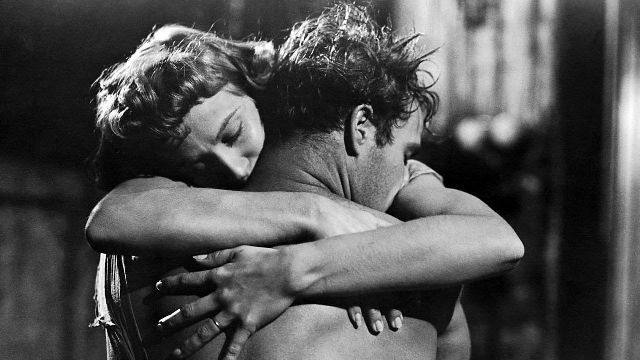A Streetcar Named Desire (1951) 
“THE PULITZER PRIZE PLAY of New Orleans’ Latin Quarter…of a Lonely Girl…of Emotions Gone Savage!”

A Streetcar Named Desire (1951)
Director: Elia Kazan
Cast: Vivien Leigh, Marlon Brando, Kim Hunter
Synopsis: Disturbed Blanche DuBois moves in with her sister in New Orleans and is tormented by her brutish brother-in-law while her reality crumbles around her.
Elia Kazan’s blistering adaptation of Tennessee Williams’ celebrated stage play was inevitably toned down for the screen thanks to the Production Code which was still in force in 1951. In addition to preventing any overt references to homosexuality or rape, the Code insisted on a major change which considerably weakened the film’s ending. Nevertheless, A Streetcar Named Desire remains arguably the best screen adaptation of Williams’ work. Whether that makes it a good movie depends on whether you like the playwright’s work, of course. For me, Williams’ dialogue is sometimes a little too precious, particularly when coming from the mouths of characters like Blanche DuBois.
Blanche is played by Vivien Leigh (Gone With the Wind, 21 Days Together), and we can only wonder whether the actress’s own psychological frailty might have informed her remarkable interpretation of the Southern faded belle who seeks to shut out reality by retreating into a world of romantic fantasy. Blanche is one of the stage’s most memorable characters, and Leigh plays her note-perfect. In the 27-year-old Marlon Brando (On the Waterfront, The Godfather) she has the quintessential Stanley Kowalski, a brooding Neolithic brute of a man whose primitive emotions mask a surly, animal-like cunning. He was at his most athletic back then, and this physical perfection was important to the plot, to emphasise the fascination he held for both Blanche and her sister Stella (Kim Hunter – A Matter of Life and Death) despite themselves.
We get to know a lot about all three characters, and most of it is unflattering. Our sympathies shift from one to the other as the story unfolds, but ultimately we must side with the poor, pathetic Blanche as her romantic delusions collude with Stanley’s brutality towards her to lead to a breakdown that was never far from the surface. It’s testimony to the performances of the three leads – and a young Karl Malden (On the Waterfront, Billion Dollar Brain) as a mother’s boy who provides a potential love interest for Blanche – that we never completely dislike any of them until the final few scenes. But it’s not just the writing and the performances that makes A Streetcar Named Desire such an experience – the set decoration adds immeasurably to the sense of pent-up tension (Kazan actually had the set made smaller for later scenes to emphasise the sense of stifling claustrophobia) while the way that Kazan captures the sultry, sweltering feel of New Orleans in a heatwave reinforces the impression that we’re watching a bunch of trapped animals just moments away from tearing one another apart.
(Reviewed 22nd December 2014)
httpv://www.youtube.com/watch?v=FVDecBMyyZI

